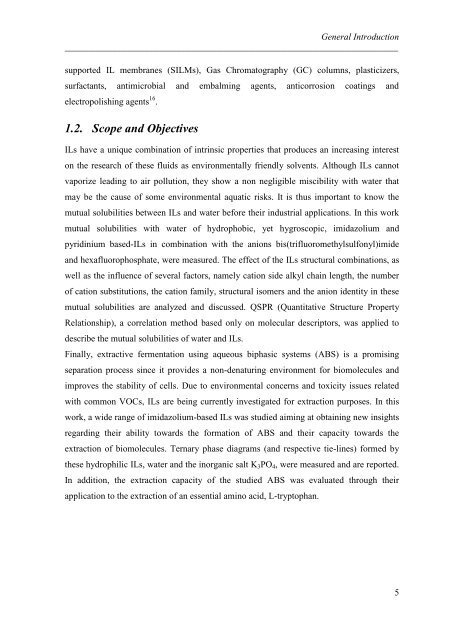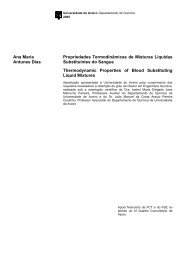Catarina Maia Seco Seiça Neves Sistemas Aquosos Bifásicos com ...
Catarina Maia Seco Seiça Neves Sistemas Aquosos Bifásicos com ...
Catarina Maia Seco Seiça Neves Sistemas Aquosos Bifásicos com ...
You also want an ePaper? Increase the reach of your titles
YUMPU automatically turns print PDFs into web optimized ePapers that Google loves.
General Introduction<br />
_________________________________________________________________________<br />
supported IL membranes (SILMs), Gas Chromatography (GC) columns, plasticizers,<br />
surfactants, antimicrobial and embalming agents, anticorrosion coatings and<br />
electropolishing agents 16 .<br />
1.2. Scope and Objectives<br />
ILs have a unique <strong>com</strong>bination of intrinsic properties that produces an increasing interest<br />
on the research of these fluids as environmentally friendly solvents. Although ILs cannot<br />
vaporize leading to air pollution, they show a non negligible miscibility with water that<br />
may be the cause of some environmental aquatic risks. It is thus important to know the<br />
mutual solubilities between ILs and water before their industrial applications. In this work<br />
mutual solubilities with water of hydrophobic, yet hygroscopic, imidazolium and<br />
pyridinium based-ILs in <strong>com</strong>bination with the anions bis(trifluoromethylsulfonyl)imide<br />
and hexafluorophosphate, were measured. The effect of the ILs structural <strong>com</strong>binations, as<br />
well as the influence of several factors, namely cation side alkyl chain length, the number<br />
of cation substitutions, the cation family, structural isomers and the anion identity in these<br />
mutual solubilities are analyzed and discussed. QSPR (Quantitative Structure Property<br />
Relationship), a correlation method based only on molecular descriptors, was applied to<br />
describe the mutual solubilities of water and ILs.<br />
Finally, extractive fermentation using aqueous biphasic systems (ABS) is a promising<br />
separation process since it provides a non-denaturing environment for biomolecules and<br />
improves the stability of cells. Due to environmental concerns and toxicity issues related<br />
with <strong>com</strong>mon VOCs, ILs are being currently investigated for extraction purposes. In this<br />
work, a wide range of imidazolium-based ILs was studied aiming at obtaining new insights<br />
regarding their ability towards the formation of ABS and their capacity towards the<br />
extraction of biomolecules. Ternary phase diagrams (and respective tie-lines) formed by<br />
these hydrophilic ILs, water and the inorganic salt K3PO4, were measured and are reported.<br />
In addition, the extraction capacity of the studied ABS was evaluated through their<br />
application to the extraction of an essential amino acid, L-tryptophan.<br />
5



